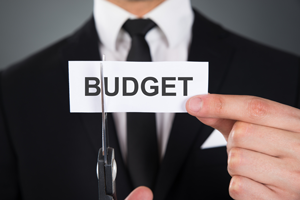Put Savings (and Yourself) First With a Budget
 Americans, it seems, are spenders. Although personal savings rates have increased recently, they remain low by historical standards, as many people continue to spend beyond their means.
Americans, it seems, are spenders. Although personal savings rates have increased recently, they remain low by historical standards, as many people continue to spend beyond their means.
If you’re among those Americans who can’t seem to save, it might be time to create a budget. A budget allows you to understand where the money goes and may help you free up cash for important savings goals, such as college and retirement.
Getting Started
Setting up a budget will require some work, but the benefits more than offset the time invested. How you create your budget is up to you. You may choose a piece of financial planning software such as Quicken, or you may choose the paper and pencil route. The worksheet below is a simple yet inclusive budget that you can use to get started.
The first element of any budget is your income, or how much money you receive each month. This can include paychecks, legal settlements, alimony, royalties, fees, and dividends from investments that you do not reinvest. Once you know what your monthly income is, you can use a budget to make sure you don’t spend more than you earn, thus helping to reduce debt and freeing up cash for savings.
Next, you need to know how you spend your money. Start by tracking your spending for a month. Gather bills and receipts, and don’t forget to include newspapers from the corner store and trips to the soda machine. Don’t assume any expense is too small to record.
Write down your expenses and break them into categories. Using the budget worksheet as an example, we find Fixed Committed Expenses — mortgage, loan, and insurance payments that stay the same from month to month; Other Committed Expenses — things you can’t live without, like food, utilities, and clothing; and Discretionary Expenses — things you like but don’t necessarily need.
Less Spending = More Savings
Once you know where the money goes, it’s time to analyze your expenses. There probably isn’t much you can do about Fixed Committed Expenses without moving or getting rid of the family car. However, if these expenses are greater than your monthly income, you are probably carrying too much debt to effectively save.
You may find some room to economize in Other Committed Expenses, but look at Discretionary Expenses first. This is typically the easiest place to reduce spending. Begin by canceling magazine subscriptions to titles you don’t read. Eat fewer meals out, or choose less expensive restaurants. Across much of the country, you can rent two videos for the price of a single adult ticket to a movie and throw in some microwave popcorn for a dollar more.
 |
Digging Deeper
Once you’ve reduced discretionary spending, look at those Other Committed Expenses. Can you reduce the grocery bill with coupons or more economical meals? How about taking public transportation instead of cabs?
One area to closely examine is credit card debt. If a high balance is keeping you from saving, you need to find ways to trim those monthly payments. Call your credit card company and ask them for an interest-rate reduction, or shop around for a card with a lower rate. You can find lists of low-rate cards through sites such as CardTrak and Bankrate. Beware of low introductory “teaser” rates that increase to much higher rates after six months.
You could also consider a home equity loan, which may offer a tax deduction, or a consolidation loan. Make sure that you’ll be able to afford the monthly payments before you take the loan. Banks can foreclose on a home equity loan within 90 days if you miss payments.
If your savings are still being crushed under the weight of debt, or if you’re having trouble making minimum monthly payments and covering necessary expenses, consider getting some help. The nonprofit National Foundation for Credit Counseling can help you set up a budget and negotiate payment schedules with lenders for a modest fee. Once you start paying off your credit cards, the extra money can be used to build savings.
The Goal: More Savings
Once you’ve figured out where to economize, you can enter amounts in the Expected column of the budget. Notice that Savings and Children’s Education appear under Fixed Committed Expenses. This is to encourage you to pay yourself first, a key rule of saving. By setting aside a certain amount each month for savings, you can build toward your goal without missing the money. You may be able to set up a payroll savings plan through your bank or credit union. Also look into any employer-sponsored retirement plans you may have at work, which potentially offer tax benefits along with savings for the future.
It might also help to set a savings goal, both for short- and long-term needs. Studies have revealed that families with savings goals tend to save more.
Remember that your budget is a living document. As your circumstances change, so will your goals and needs. Review your budget every few months to make sure it reflects your goals and to see if you are saving as much as you possibly can.
Because of the possibility of human or mechanical error by Wealth Management Systems Inc. or its sources, neither Wealth Management Systems Inc. nor its sources guarantees the accuracy, adequacy, completeness or availability of any information and is not responsible for any errors or omissions or for the results obtained from the use of such information. In no event shall Wealth Management Systems Inc. be liable for any indirect, special or consequential damages in connection with subscriber’s or others’ use of the content.
© 2016 Wealth Management Systems Inc. All rights reserved.




